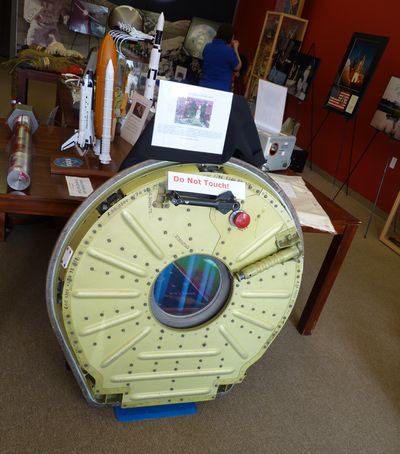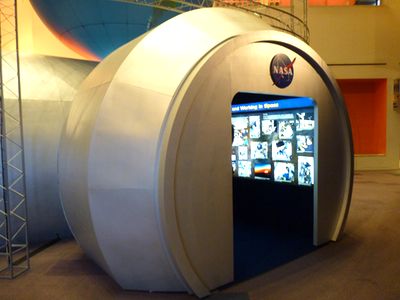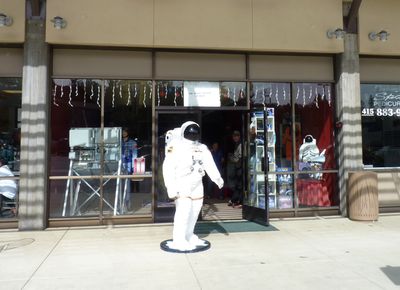Bringing space exhibits down to earthby Jeff Foust
|
| Families and others shopping at the center dropped into the free museum, their curiosity piqued, perhaps, by the astronaut outside and the glimpse of space hardware visible through the open doorway. |
Inside the small space is a basic set of displays of artifacts, photos, and other items. The museum has a hodgepodge of both American and Russian items, ranging from a Space Shuttle hold-down bolt and a Lunar Module engine bell to a Soviet-era cosmonaut flight suit and a hatch from the Buran shuttle. The theme of the current exhibit is “Space Stations and Space Shuttles” (exhibits are changed every several months), although to many visitors that theme may be too subtle, who instead simply see a collection of flight hardware and other items representing spaceflight.
 A hatch from a Soviet-era Buran shuttle and a hold-down bolt (left) from the American shuttle program are among the artifacts on display at The Space Station museum. (credit: J. Foust) |
For the hardcore space enthusiast, there are some interesting items, but no rare “must-see” artifacts that require a visit. However, the audience for this museum is something broader. The W Foundation opened The Space Station last October to “help educate children about the exciting history of space exploration” and explain the importance of space exploration to the general public. The museum appeared to be fulfilling that mission during a visit on a pleasant Sunday afternoon a few weeks ago: families and others shopping at the center dropped into the free museum, their curiosity piqued, perhaps, by the astronaut outside and the glimpse of space hardware visible through the open doorway.
Another space exhibit can be found—temporarily—in another museum a little more than 100 kilometers’ drive south down Highway 101. The Tech Museum in downtown San Jose, a general science and technology museum, is hosting NASA’s “Destination: Station” exhibit through April 15. The traveling exhibit, which has made previous stops in Ohio and Denver, is intended to educate the public primarily on the types of research being done on the ISS as the station transitions from its assembly phase to full-fledged operations. At the heart of the exhibit is a T-shaped module that people can walk through, its interior walls displaying photos, videos, and descriptions of the work being done on the station.
 The “Destination: Station” exhibit, currently on display at The Tech Museum in San Jose, features a module that visitors can walk through to see what research goes takes place on the ISS. (credit: J. Foust) |
In San Jose, though, the exhibit is playing another role: reminding the public of the region’s connection to the space agency, which is often lost in the glare of attention devoted to Silicon Valley’s numerous technology companies. At a reception for the exhibit on March 1, the day before it opened to the public, Ames Research Center deputy director Lew Braxton noted that the center’s contributions to ISS research and other agency activities are often overlooked, even by people in the area, some of whom are even unaware the center is just a short drive up the freeway from the museum. He said he spoke to someone at the reception who “was trying to figure out where Ames Research Center is, and she’s from the area.” (It helps to point out that Ames is home to Hangar One, the iconic—and, now, partially denuded—giant hangar that is one of the distinctive structures visible from the 101 freeway while driving through the area.) Officials hope that the exhibit and events planned around it will help make the community more aware of the part of the space program that’s in their backyard.
Similarly, little museums like The Space Station, which can’t compete with the Smithsonian or NASA visitor centers in the size and historic quality of their exhibits, can still help raise the profile of space to the public. They demonstrate that space is special, but it doesn’t have to be distant. Space is, after all, only 100 kilometers straight up—and, perhaps, around the corner, next the grocery store.
